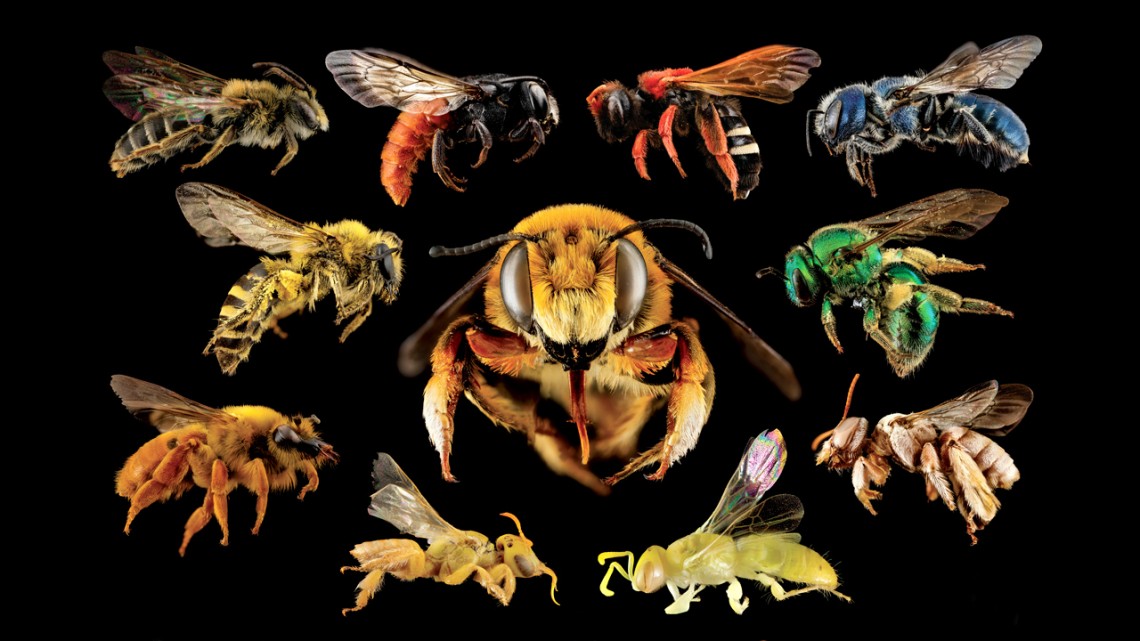
This panel shows some of the diversity found in wild bees.
Bee exhibit creates buzz at Museum of the Earth
By Krishna Ramanujan
Honeybees are the most recognizable and popular of all bees, but they account for only seven of 20,000 total described species.
A museum exhibit – created in collaboration with Cornell experts, illustrators and students – seeks to shine a light on the vast diversity of wild bees through breathtaking photos, unusual specimens, video footage and extremely rare bee fossils from as many as 100 million years ago.
Five years in the making, “Bees! Diversity, Evolution and Conservation” is on display until June 1, 2020, at the Paleontological Research Institution’s (PRI) Museum of the Earth in Ithaca.
“People hear a lot about honeybees, and they hear a little about bumblebees, but the other 96% of bees on Earth don’t get much press coverage,” said Bryan Danforth, an entomology professor and expert on wild, solitary bees. He created the exhibit with Helaina Blume, director of exhibitions at PRI, Rob Ross, associate director for outreach at PRI, and other PRI colleagues.
The creators hope that visitors will walk away from the exhibit with some understanding of what a bee is in terms of anatomy and evolution; ways that bees are considered an evolutionary success; rewards that plants provide bees and how bees harvest those rewards; where and how bees nest; the importance of bees to agricultural pollination; and things we can do to maintain wild bee populations.
“It’s important to remember biodiversity in conservation efforts,” Ross said, “and that people don’t conserve what they don’t know anything about.”
The exhibit includes extremely rare fossils in amber. The fossils – collected from the Dominican Republic, the Baltic Sea and Myanmar – are on loan from the American Museum of Natural History in New York City. One fossil dates back 100 million years (when dinosaurs lived) and was discovered by Danforth and George Poinar of Oregon State University in a mine in northern Myanmar in the early 2000s.
Many of the displays, each with a theme, include beautifully produced or rare videos, such as striking footage of Dawson’s burrowing bees (Amegilla dawsoni), a large western Australian variety, creating little nest mounds across hundreds of acres of reddish soil.
Another display contains specimens representing all 28 subfamilies of bees, including diverse and rare species from the Cornell Insect Collection. One of these, Wallace’s giant bee (Megachile pluto) – the world’s largest bee, with a wingspan of 2.5 inches – was thought to be extinct but was rediscovered in Indonesia in 1981. But these bees fetch thousands of dollars on eBay, which spurs collectors to catch them, further threatening the species’ survival.
“Let’s not worry so much about honeybees, let’s worry about the highly specialized ‘niche’ bees” that face such conservation pressures, Danforth said.
“Our goal with this exhibit was to teach our visitors about the diversity and importance of bees, human impact on bee health and consequences of their potential loss,” Blume said. “In doing that, we hope to expand visitors’ knowledge about how our actions, no matter how small, have the potential for far-reaching ripple effects and that we all can and should get involved with bee conservation.”
The exhibit offers suggestions for how visitors can improve bee conservation right in their own backyards by planting a pollinator garden, enhancing nesting spots with wood and brush piles and stone walls, and limiting pesticide use.
Danforth said the research for his recent book, “The Solitary Bees: Biology, Evolution, Conservation,”co-authored with Robert L. Minckley and John L. Neff, provided the background for creating the exhibit, which was funded in part by a grant from the National Science Foundation.
Media Contact
Get Cornell news delivered right to your inbox.
Subscribe

